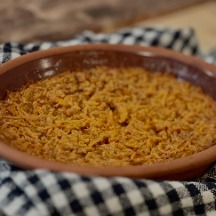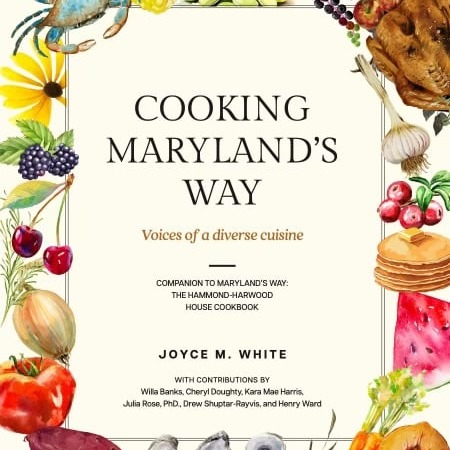Mrs. Y. Kirkpatrick-Howat, Contee, Rhode River, Anne Arundel County, MD
¼ cup butter, ½ cup sugar, 2 eggs, 2 cups grated sweet potato, grated rind of 1 orange or half a lemon, ½ teaspoon ginger, ½ teaspoon mace, dash of cinnamon, ½ cup milk.
Cream butter and sugar, add beaten eggs and sweet potato. Beat well.
Add orange or lemon rind, spices and milk, and continue to beat. Pour into a well buttered oven dish and bake in a moderate oven for 1 hour.
Good with roast duck or roast pork.
This Maryland’s Way recipe for Sweet Potato Pone, a sweet pudding, has both Native American and African American origins, making it a model dish representing two vital diverse elements of Maryland’s foundational cuisine.
First, the term pone comes from a Native American word for a type of cornmeal bread or pudding. Second, enslaved Africans brought to Maryland from the Caribbean or West Indies a taste for sweet potato pone, a dish they learned to make in the islands.
In general, sweet potatoes, whether made into pone or any other dish, were an important source of food for everyone in colonial Maryland but are historically linked with African American foodways, especially among the enslaved.
A Look at Sweet Potatoes
Many people assume that sweet potatoes and white potatoes are related; however, though similar in appearance, they come from very different plants. Both plants are native to South America, but sweet potatoes are in the morning glory family whereas white potatoes are nightshades.
However, sweet potatoes and yams are very different. There are two key reasons for this confusion. First, Christopher Columbus thought sweet potatoes were yams, just like the ones he encountered on voyages he took along West Africa’s coast in the 1460s.
It is generally accepted that sweet potatoes were first domesticated in South America in Peru around five thousand years ago. However, morning glory plant fossils dating back 700 years in Polynesia and 57 million years in eastern India have been discovered.
These discoveries make pin pointing the exact origins of sweet potatoes difficult. What is known for sure is that they were well-established in South and Central America by the time Christopher Columbus arrived in the New World. Furthermore, Columbus brought them to Europe where their use spread across the continent. They eventually traveled back across the Atlantic Ocean to North America and the Caribbean Islands through the Columbian Exchange of plants, animals, diseases, and human beings.
Sweet potatoes were an important carbohydrate for many people living in the American South in the 18th and 19th centuries, particularly among enslaved African Americans forced to work on plantations. They added much needed calories and bulk to meagre rations, and were readily adopted by Africans brought to North America because of their resemblance to African yams.
However, sweet potatoes and yams are very different. Yams are not in the morning glory family; instead, they derived from a West African perennial herbaceous vine called Dioscorea, a product not commonly found in American supermarkets. This confusion is so deeply embedded within the American lexicon that even today the terms sweet potatoes and yams continue to be used interchangeably.
There are two key reasons for this confusion. First, Christopher Columbus thought sweet potatoes were yams, just like the ones he encountered on voyages he took along West Africa’s coast in the 1460s. Second, this association strengthened over time because, while early varieties of sweet potatoes remained firm when cooked and were therefore not at all like yams, newer varieties were introduced that softened during the cooking process making them very similar to African yams.
According to food historian Michael Twitty, for many enslaved people sweet potatoes were "second in importance to corn as a starch." Many reasons explain why sweet potatoes became so central to the diet of the enslaved. They are a good source of both nutrients and calories which were sorely lacking in their standard food ration allocations. Sweet potatoes are also practical because they are easy to grow and disease resistant. These factors, combined with affordability, versatility, and good taste, account for the high value placed on sweet potatoes in the foodways of African American Marylanders, as well as among the wider population.
Sweet Potato Pone Sweet potatoes are an extremely versatile food. They can be roasted, stewed, broiled, baked, fried, boiled, mashed, glazed or candied, added to soups and stews, and made into waffles, breads, buns, biscuits, pies, puddings, and pone. Sweet potato pones are firm custard-like puddings that likely emerged in the Caribbean Islands. They were made from either mashed or grated potatoes. In 1725, Sir Hans Sloane, British doctor and founder of the British Museum, visited Jamaica where he encountered sweet potato pone. He wrote, "patatas bak'd are excellent Food and call'd Pone." Island-made sweet potato pone usually contained coconut milk; in contrast, North American pones were made with milk and/or cream. Documented recipes for sweet potato pone in Maryland date back to the mid-19th century, but were probably made for generations before they were documented.
Cooking Maryland’s Way: Voices of a Diverse Cuisine by Joyce M. White
Hammond-Harwood House Museum
Annapolis, Maryland
2024








